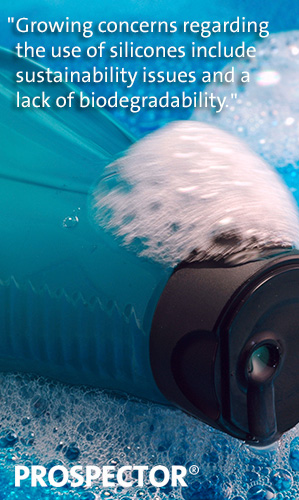 Silicones have been widely used in 2-in-1 conditioning shampoos since the launch of Pert Plus by Procter and Gamble in 1987. They provide exceptional wet comb properties, and they don’t negatively impact foam. Typically, a high molecular dimethicone is used in combination with a cationic polymer as the conditioning agent.
Silicones have been widely used in 2-in-1 conditioning shampoos since the launch of Pert Plus by Procter and Gamble in 1987. They provide exceptional wet comb properties, and they don’t negatively impact foam. Typically, a high molecular dimethicone is used in combination with a cationic polymer as the conditioning agent.
But there are growing concerns regarding the use of silicones in hair care products due to sustainability issues and a lack of biodegradability. Use my list of recommended non-silicone materials below to find a suitable replacement for silicones in your hair care formulations.
Non-Silicone Products
Luviquat® Sensation by BASF (Polyquaternium 87, 26% solids in water)
This product outperforms Polyquaternium 10 and Hydroxypropyltrimonium Guar for wet comb force reduction with or without silicone at .2% solids.
EU: Luviquat® Sensation | BASF
Lamesoft® Care by BASF (PEG-4 Distearyl Ether, Sodium Laureth Sulfate, Distearyl Ether, Dicaprylyl Ether)
This wax dispersion matches the performance of silicone-based shampoos in testing when used at 2-5% in formulations. Other applications include body washes, shave creams, and facial cleansers.
EU: Lamesoft® Care
Plantasil® Micro by BASF (Dicaprylyl Ether, Decyl Glucoside, Glyceryl Oleate)
This product is a conditioning agent for producing clear shampoos. A formulation containing 3% Plantasil Micro and PQ 10 was shown to decrease wet combing by over 40%.
EU: Plantasil® Micro
EcoSmooth Silk by Dow Chemical (Ethylene/Octene Copolymer, Ethylene/Sodium Acrylate Copolymer)
This new non-anionic hair conditioning polymer is comprised of 40-44% ethylene copolymers dispersed in water at a PH of 9.5-10. Consumer testing has demonstrated that EcoSmooth Silk (all prototypes also contain .25% cationic guar):
- Has improved hair volume vs. silicone.
- Matches silicone conditioning performance among Asian virgin and bleached hair.
- Provides equal wet comb force reduction vs. silicone and provides equal protection against hair breakage vs. silicone (bleached brown European hair).
EU: EcoSmooth Silk | Dow Chemical
Merquat 2003PR® by Lubrizol (Polyquaternium-53)
Combined with Merquat 5210 (Polyquaternium 52, Laureth 16-Lubrizol) in a silicone-free shampoo, Merquat 2003PR was shown to provide exceptional conditioning and sensory properties. Foam enhancement and color retention on dyed hair was also observed.
EU: Merquat 2003PR® | Lubrizol
Jaguar® Optima by Solvay Novecare (Guar Hydroxypropyltrimonium Chloride)
This cationic Guar’s charge density and molecular weight has been optimized for conditioning and deposition. Shampoo prototypes containing Optima have been shown to outperform several market-leading, silicone-containing shampoos for wet combing.
EU: Solvay Novecare
Crodazosoft SC by Croda (Quaternium 91 and PPG-3 Benzyl Ether Myristate)
This product was shown to provide noticeable hair softness from a non-silicone shampoo base when used at 1.5%. It also provided excellent conditioning on both wet and dry hair.
EU: Crodazosoft SC | Croda
Performa™ 1480 by New Phase Technologies (C 20-40 Alcohols, Cocamidopropyl Betaine, 45% dispersion of C20-40 alcohols)
When used in body washes/shampoos this product helps to deposit emollients/conditioners and provides a pearlescent effect to the product. Shampoos containing 5% Performa 1480 also demonstrated a significant reduction in comb force on both wet and dry hair. In an in-use consumer test, 58% of panelists preferred a test product containing the 1480 versus a control (over 90% of panelist had thick or curly hair). A significant increase in foam/lather and conditioning effects were mentioned by the panelists for the test product.
EU: Performa™ 1480 | New Phase Technologies
Crodafos™ HCE by Croda (Oleth-5 Phosphate, Dioleyl Phosphate)
This product was shown to synergistically improve hair conditioning performance in a clear shampoo when combined with Polyquaternium 10.
EU: Crodafos™ HCE
The views, opinions and technical analyses presented here are those of the author or advertiser, and are not necessarily those of ULProspector.com or UL Solutions. The appearance of this content in the UL Prospector Knowledge Center does not constitute an endorsement by UL Solutions or its affiliates.
All content is subject to copyright and may not be reproduced without prior authorization from UL Solutions or the content author.
The content has been made available for informational and educational purposes only. While the editors of this site may verify the accuracy of its content from time to time, we assume no responsibility for errors made by the author, editorial staff or any other contributor.
UL Solutions does not make any representations or warranties with respect to the accuracy, applicability, fitness or completeness of the content. UL Solutions does not warrant the performance, effectiveness or applicability of sites listed or linked to in any content.



Dear,
What are specific properties that a silicone-alternative ingredient must comply with?
Thanks
Hi, Dea.
It depends on the application. Could you please provide additional detail?
Thank you,
George